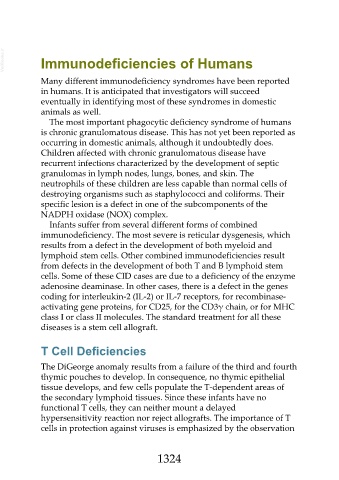Page 1324 - Veterinary Immunology, 10th Edition
P. 1324
VetBooks.ir Immunodeficiencies of Humans
Many different immunodeficiency syndromes have been reported
in humans. It is anticipated that investigators will succeed
eventually in identifying most of these syndromes in domestic
animals as well.
The most important phagocytic deficiency syndrome of humans
is chronic granulomatous disease. This has not yet been reported as
occurring in domestic animals, although it undoubtedly does.
Children affected with chronic granulomatous disease have
recurrent infections characterized by the development of septic
granulomas in lymph nodes, lungs, bones, and skin. The
neutrophils of these children are less capable than normal cells of
destroying organisms such as staphylococci and coliforms. Their
specific lesion is a defect in one of the subcomponents of the
NADPH oxidase (NOX) complex.
Infants suffer from several different forms of combined
immunodeficiency. The most severe is reticular dysgenesis, which
results from a defect in the development of both myeloid and
lymphoid stem cells. Other combined immunodeficiencies result
from defects in the development of both T and B lymphoid stem
cells. Some of these CID cases are due to a deficiency of the enzyme
adenosine deaminase. In other cases, there is a defect in the genes
coding for interleukin-2 (IL-2) or IL-7 receptors, for recombinase-
activating gene proteins, for CD25, for the CD3γ chain, or for MHC
class I or class II molecules. The standard treatment for all these
diseases is a stem cell allograft.
T Cell Deficiencies
The DiGeorge anomaly results from a failure of the third and fourth
thymic pouches to develop. In consequence, no thymic epithelial
tissue develops, and few cells populate the T-dependent areas of
the secondary lymphoid tissues. Since these infants have no
functional T cells, they can neither mount a delayed
hypersensitivity reaction nor reject allografts. The importance of T
cells in protection against viruses is emphasized by the observation
1324

